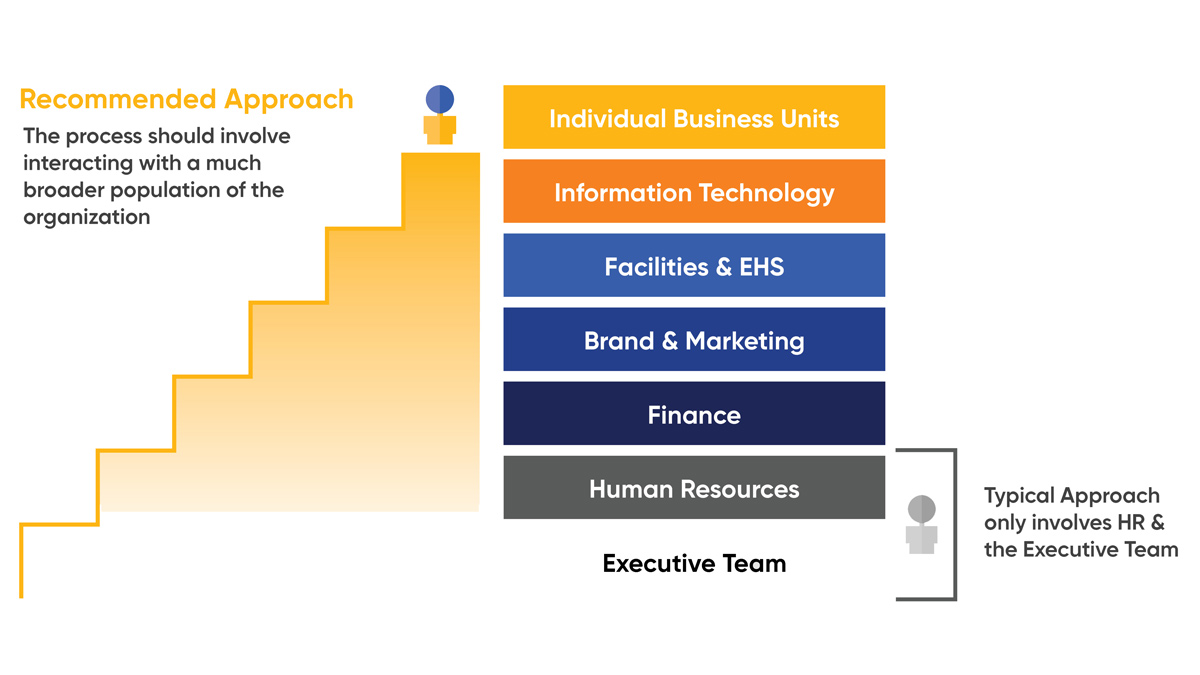Everyone’s approach will be different—unique cultures require unique solutions. Flexibility is key.
This blog was originally published by DCEO Magazine on DMagazine.com
Perhaps now more than ever, there is an opportunity for businesses to approach their real estate differently. Now is a time to think beyond space, to plan for and implement a workplace strategy in order to enable greater office flexibility while optimizing workforce efficiencies.
So, why is Workplace Strategy so important?
Let me first admit that the title of this document includes an intentional twist, “especially in challenging times”. Excellent workplace strategy is not best deployed when entering challenging times. Its highest and best value is realized when it has been initiated before difficulties arise. It should provide both high-level flexibility – to respond to unique circumstances and tactical methodology – to make the work environment as productive as possible.
Proper approach to execute effective workplace strategy?
Traditional real estate models and practices typically begin with brokers engaging the key person within an organization who is responsible for real estate strategy, process and decision making. That person bore the full weight and responsibility of gathering, synthesizing and presenting the organization’s objectives. The brokers then identify appropriate solutions to meet those objectives.
The inverse of that model starts with C-Suite authorization, and collaborating workplace strategists to perform deep-dive discovery through the entire organization. Gathering accurate information is vital for real estate decision maker(s), to then inform on and plan for the real estate strategy.
Why would a CRE allow this?
I have often found that team members will share information with a third-party advisor that they might otherwise be afraid to share with the boss. First, discovery findings are completely confidential – providing a much more honest assessment of the true state of the organization and indicating where improvements are needed. Second, the approach does not lessen the responsible person’s authority, it actually empowers it with better information.
Workplace Strategy must include discovery throughout the entire organization; every department, every user group, external service providers, and even clients, to give the most robust perspective of the organization’s current condition and opportunities for improvement. Once information is gathered and synthesized for the organization’s leadership, decisions can be made toward a go-forward strategy.

The workplace strategy approach also must include specific data-analytics - data points that provide exponentially impactful information. Data collected and aggregated is derived from sources relating to an organization’s workforce, demographics, consumers, real estate, firmographic and proprietary data.
It is critical to understand that workplace strategy is not a “once and done” event. Periodic workplace audits are recommended to check the pulse of the organization at a mutually determined cadence. Organizations are not static; they are vibrant “organisms” wherein change happens daily, monthly and on an annual basis. We want to verify that the workplace is responding to that change. This is the only way to ensure the highest functioning work environment.
In the midst of the current pandemic, we are learning:
- We can all work remotely with the right technology and personal diligence.
- Space standards will change
- Some will grow to accommodate distancing (this may last for only a time)
- Some will shrink with more workers only visiting the office periodically on a staggered schedule.
- The office is important for social interaction with friends and co-workers (our secondary family) in addition to being a place to perform work. While we have worked from home, we notice how much we miss our co-workers and the power of physically being together.
No matter what we are learning, one thing is certain, change is always on the horizon. Employing a nimble workplace strategy prepares us for whatever comes next.


